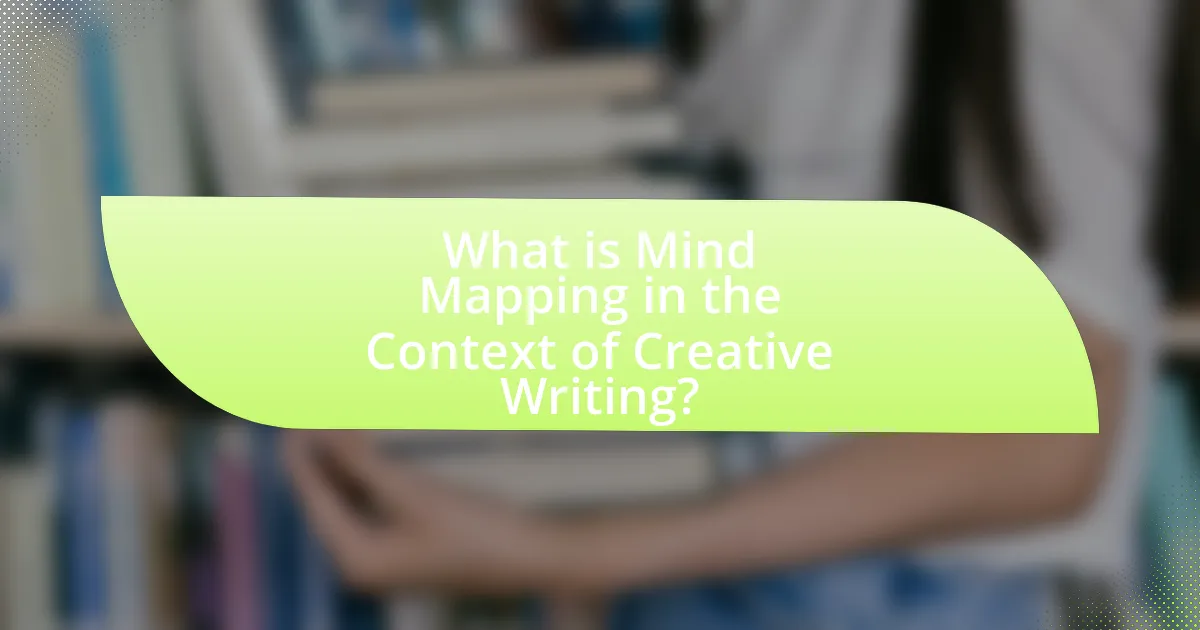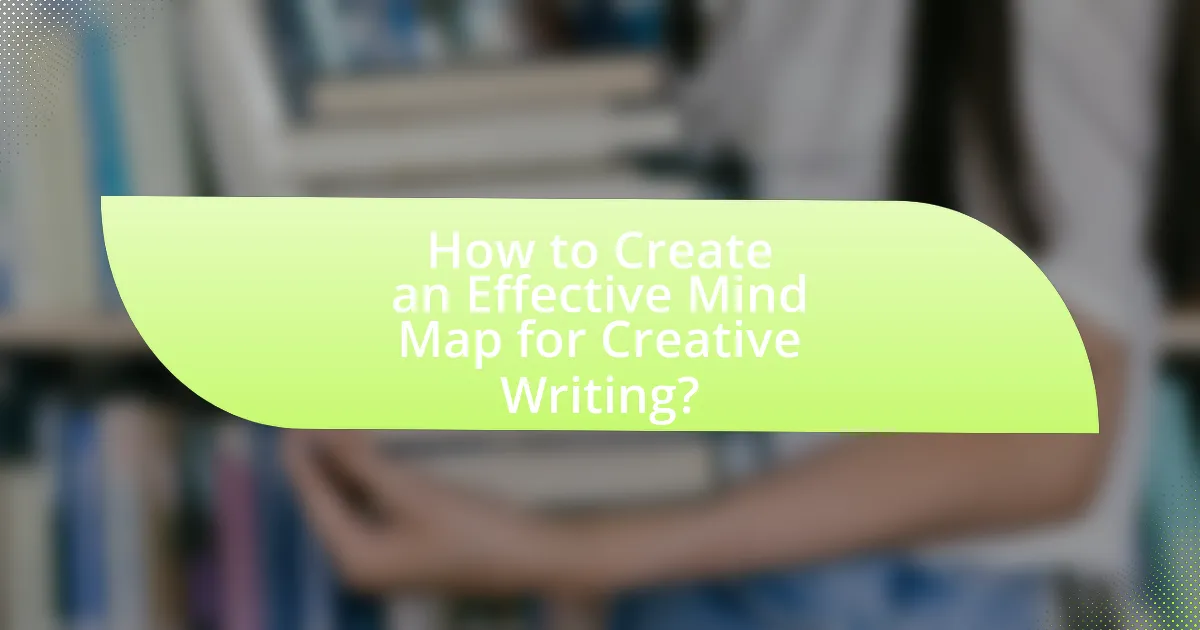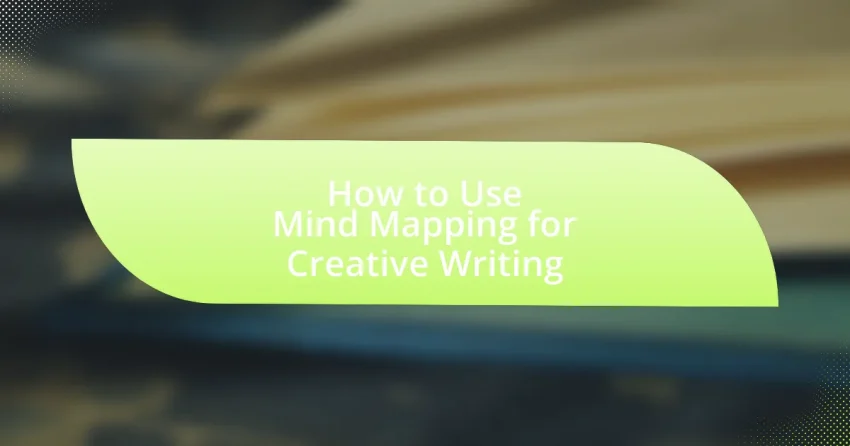Mind mapping is a visual brainstorming technique that aids creative writers in organizing thoughts and ideas, enhancing clarity and creativity in the writing process. This article explores the benefits of mind mapping, including improved memory retention and idea generation, as well as its key elements such as central themes, branches, and visual aids. It also discusses practical steps for creating effective mind maps, common mistakes to avoid, and strategies for integrating mind mapping into the writing routine. Additionally, the article addresses potential challenges writers may face while mind mapping and offers solutions to overcome mental blocks and maintain motivation.

What is Mind Mapping in the Context of Creative Writing?
Mind mapping in the context of creative writing is a visual brainstorming technique that helps writers organize their thoughts and ideas. This method allows writers to create a diagram that connects related concepts, themes, and characters, facilitating a clearer understanding of the narrative structure. Research indicates that mind mapping can enhance creativity and improve information retention, making it a valuable tool for writers seeking to develop complex plots or character arcs. By visually representing ideas, writers can identify relationships and gaps in their narratives, ultimately leading to more cohesive and engaging stories.
How does mind mapping facilitate the creative writing process?
Mind mapping facilitates the creative writing process by visually organizing thoughts and ideas, which enhances clarity and creativity. This technique allows writers to break down complex concepts into manageable components, making it easier to explore relationships between ideas. Research indicates that visual aids, such as mind maps, can improve memory retention and idea generation, as demonstrated in studies by Buzan and others, which show that visual thinking can lead to more innovative outcomes. By structuring information in a non-linear format, mind mapping encourages free association and brainstorming, ultimately leading to a more fluid and dynamic writing process.
What are the key elements of a mind map for writers?
The key elements of a mind map for writers include a central idea, branches for main themes, sub-branches for supporting details, and visual elements such as colors and images. The central idea represents the primary topic or theme of the writing project, while branches extend from this core to outline major concepts or sections. Sub-branches further break down these concepts into specific points or ideas, facilitating a structured approach to brainstorming and organizing thoughts. Visual elements enhance memory retention and engagement, making the mind map more effective as a creative tool. Research indicates that visual aids can improve information retention by up to 65%, supporting the effectiveness of mind mapping in writing.
How can visual representation enhance idea generation?
Visual representation enhances idea generation by facilitating cognitive processing and improving memory retention. When ideas are visually mapped, such as through mind maps, individuals can see relationships and hierarchies among concepts, which promotes deeper understanding and creativity. Research indicates that visual aids can increase information retention by up to 65%, as they engage both the analytical and creative parts of the brain, allowing for more innovative connections and solutions. This dual engagement is crucial in creative writing, where the ability to visualize concepts can lead to richer narratives and more complex character development.
Why should writers consider using mind mapping?
Writers should consider using mind mapping because it enhances creativity and organization in the writing process. Mind mapping allows writers to visually structure their ideas, making it easier to explore connections and generate new concepts. Research indicates that visual tools like mind maps can improve memory retention and comprehension, as they engage both the left and right hemispheres of the brain. A study published in the journal “Educational Psychology” by Buzan and Buzan found that mind mapping can increase productivity and creativity by up to 20%. This method not only aids in brainstorming but also helps in outlining and structuring narratives effectively.
What advantages does mind mapping provide over traditional outlining?
Mind mapping offers several advantages over traditional outlining, primarily through its visual representation of ideas. This method enhances creativity by allowing users to see connections between concepts, which can lead to more innovative thinking. Research indicates that visual learning can improve information retention by up to 65%, compared to 10% for verbal learning alone. Additionally, mind mapping encourages a non-linear approach, enabling writers to explore ideas freely without the constraints of a hierarchical structure, thus fostering a more organic flow of thoughts. This flexibility can lead to richer content and more engaging narratives in creative writing.
How does mind mapping improve organization and clarity in writing?
Mind mapping improves organization and clarity in writing by visually structuring information, allowing writers to see relationships between ideas. This technique enables the identification of main concepts and subtopics, facilitating a coherent flow of thoughts. Research indicates that visual aids, such as mind maps, enhance memory retention and comprehension, as evidenced by a study published in the journal “Educational Psychology,” which found that students using mind maps scored higher on recall tests compared to those using linear notes. By organizing ideas in a non-linear format, mind mapping helps writers streamline their thoughts, making it easier to develop a clear and focused narrative.

How to Create an Effective Mind Map for Creative Writing?
To create an effective mind map for creative writing, start by placing your central idea or theme in the center of the map. From this central point, branch out into main categories or concepts related to your theme, such as characters, plot points, settings, and themes. Each of these branches can further divide into sub-branches that detail specific elements, like character traits, plot twists, or sensory details about the setting. This visual organization helps in brainstorming and structuring ideas, making it easier to see connections and develop a cohesive narrative. Research indicates that mind mapping enhances creativity and information retention, as shown in studies by Buzan and others, which highlight its effectiveness in organizing thoughts and fostering innovative thinking.
What steps should be followed to create a mind map?
To create a mind map, start by identifying the central idea or topic you want to explore. Next, draw a circle around this central idea on a blank page. From this central circle, branch out with lines to subtopics or related ideas, creating additional circles for each subtopic. Then, further expand each subtopic with more branches that detail specific points or concepts related to them. Use keywords, images, and colors to enhance the visual appeal and memory retention of the mind map. This structured approach allows for a clear representation of thoughts and relationships, facilitating creative writing by organizing ideas effectively.
How do you choose a central theme for your mind map?
To choose a central theme for your mind map, identify the primary subject or idea you want to explore. This involves brainstorming key concepts related to your creative writing project, such as character development, plot structure, or thematic elements. Once you have a list of potential ideas, select the one that resonates most with your writing goals and can serve as a focal point for further exploration. Research indicates that a well-defined central theme enhances clarity and organization in creative processes, making it easier to generate and connect related ideas effectively.
What techniques can be used to branch out ideas effectively?
Techniques to branch out ideas effectively include mind mapping, free writing, and the use of prompts. Mind mapping visually organizes thoughts, allowing for the exploration of connections between ideas, which enhances creativity and clarity. Free writing encourages the flow of thoughts without self-censorship, leading to unexpected insights and new directions. Prompts can stimulate thinking by providing specific scenarios or questions that challenge existing perspectives. These techniques are supported by research indicating that visual and free-form methods can significantly enhance creative output and idea generation.
What tools are available for mind mapping?
Several tools are available for mind mapping, including software applications and online platforms. Popular options include MindMeister, which allows for collaborative mind mapping in real-time, and XMind, known for its user-friendly interface and various templates. Other notable tools are Coggle, which offers a simple, visual approach, and FreeMind, an open-source option that provides basic mind mapping features. These tools enhance the creative writing process by enabling writers to organize thoughts visually and explore ideas systematically.
Which digital tools are most popular for mind mapping?
The most popular digital tools for mind mapping include MindMeister, XMind, and Coggle. MindMeister is widely recognized for its collaborative features, allowing multiple users to work on a mind map simultaneously, which is beneficial for creative writing projects. XMind offers a variety of templates and export options, making it versatile for different writing styles. Coggle is known for its simplicity and ease of use, enabling quick creation of visually appealing mind maps. These tools are frequently used by writers and creatives to organize thoughts and ideas effectively, enhancing the brainstorming process.
How can traditional pen-and-paper methods be effective for mind mapping?
Traditional pen-and-paper methods can be effective for mind mapping because they allow for unrestricted creativity and flexibility in organizing thoughts. Using physical materials, individuals can easily draw connections, add colors, and create visual representations that enhance memory retention and comprehension. Research indicates that writing by hand engages different cognitive processes compared to typing, leading to improved understanding and recall of information. A study published in the journal “Psychological Science” by Pam A. Mueller and Daniel M. Oppenheimer found that students who took notes by hand performed better on conceptual questions than those who typed, highlighting the cognitive benefits of traditional methods.

What are the Best Practices for Using Mind Mapping in Creative Writing?
The best practices for using mind mapping in creative writing include starting with a central idea, branching out with related concepts, and using keywords or images for clarity. This approach allows writers to visually organize their thoughts, facilitating the exploration of themes and character relationships. Research indicates that visual aids like mind maps enhance memory retention and idea generation, making them effective tools for writers. For instance, a study published in the journal “Educational Psychology” by Buzan and Buzan demonstrates that mind mapping can improve creative thinking and problem-solving skills, which are essential in the writing process.
How can writers maximize the effectiveness of their mind maps?
Writers can maximize the effectiveness of their mind maps by ensuring clarity and organization in their visual representation of ideas. This involves using clear labels, color coding, and hierarchical structures to differentiate between main concepts and subtopics. Research indicates that visual aids, such as mind maps, enhance memory retention and comprehension, as evidenced by a study published in the Journal of Educational Psychology, which found that students who utilized mind mapping scored significantly higher on recall tests compared to those who did not. By incorporating these strategies, writers can create more impactful and easily navigable mind maps that facilitate the creative writing process.
What common mistakes should be avoided when mind mapping?
Common mistakes to avoid when mind mapping include overcomplicating the structure, using too many colors or images, and failing to maintain a clear hierarchy. Overcomplicating the structure can lead to confusion and hinder the creative process, as a cluttered map makes it difficult to identify key ideas. Excessive use of colors or images can distract from the main concepts, making it harder to focus on the content. Additionally, not maintaining a clear hierarchy can result in a disorganized map, where relationships between ideas are unclear, ultimately reducing the effectiveness of the mind map in aiding creative writing.
How often should writers revisit and revise their mind maps?
Writers should revisit and revise their mind maps regularly, ideally after completing significant writing milestones or when new ideas emerge. This practice ensures that the mind map remains relevant and accurately reflects the evolving structure of the writer’s thoughts. Research indicates that regular revision enhances cognitive retention and idea organization, which is crucial for effective creative writing. By updating mind maps frequently, writers can maintain clarity and coherence in their projects, ultimately leading to more structured and impactful writing.
What are some tips for integrating mind mapping into the writing routine?
To effectively integrate mind mapping into the writing routine, start by dedicating specific time slots for mind mapping sessions before writing. This structured approach allows for focused brainstorming and idea organization. Next, utilize digital tools like MindMeister or XMind, which facilitate easy adjustments and visual clarity, enhancing the mapping process. Additionally, incorporate mind maps to outline chapters or sections, ensuring a clear flow of ideas and maintaining coherence in the writing. Research indicates that visual aids, such as mind maps, can improve retention and understanding, making them a valuable tool in the writing process.
How can mind mapping be used in different stages of the writing process?
Mind mapping can be effectively utilized in various stages of the writing process, including brainstorming, organizing, drafting, and revising. During brainstorming, mind mapping helps writers generate and visualize ideas, allowing for a free flow of thoughts without constraints. In the organizing stage, it aids in structuring these ideas into a coherent outline, showing relationships between concepts. When drafting, mind maps serve as a reference point, guiding the writer through the narrative or argument structure. Finally, during revision, mind mapping allows writers to identify gaps or redundancies in their work, facilitating a more focused and efficient editing process. Research indicates that using mind maps can enhance creativity and improve information retention, making it a valuable tool throughout the writing journey.
What strategies can help maintain motivation while using mind mapping?
To maintain motivation while using mind mapping, setting clear goals and breaking tasks into smaller, manageable parts is essential. This approach allows individuals to focus on specific sections of their mind map, making the process less overwhelming and more achievable. Research indicates that goal-setting enhances motivation by providing direction and a sense of accomplishment as each small task is completed. Additionally, incorporating visual elements and colors in mind maps can stimulate creativity and engagement, further sustaining motivation. Studies show that visual aids can improve memory retention and understanding, which reinforces the effectiveness of mind mapping in creative writing.
What are the potential challenges of using mind mapping for creative writing?
The potential challenges of using mind mapping for creative writing include difficulty in maintaining focus, potential for overwhelming complexity, and the risk of limiting creativity. Writers may struggle to concentrate on the central theme due to the expansive nature of mind maps, which can lead to distractions. Additionally, as more ideas are added, the mind map can become overly complex, making it hard to discern the main narrative or structure. This complexity can hinder the creative process by imposing a rigid framework that restricts free-flowing thought and exploration of ideas.
How can writers overcome mental blocks when mind mapping?
Writers can overcome mental blocks when mind mapping by employing techniques such as setting a timer for short bursts of focused brainstorming, using prompts to stimulate ideas, and allowing free association without judgment. Research indicates that time constraints can enhance creativity by reducing the pressure to produce perfect ideas, as shown in a study published in the Journal of Creative Behavior, which found that time-limited tasks often lead to more innovative solutions. Additionally, utilizing visual elements like colors and images in mind maps can activate different cognitive pathways, further aiding in idea generation and breaking through mental barriers.
What should writers do if they feel overwhelmed by their mind maps?
Writers who feel overwhelmed by their mind maps should simplify their maps by breaking them down into smaller, manageable sections. This approach allows writers to focus on one aspect of their project at a time, reducing cognitive load and enhancing clarity. Research indicates that cognitive overload can hinder creativity and productivity, so prioritizing and organizing thoughts into bite-sized pieces can lead to more effective writing outcomes. By concentrating on individual components, writers can gradually rebuild their mind maps into a cohesive structure without feeling overwhelmed.
What practical tips can enhance the mind mapping experience for writers?
To enhance the mind mapping experience for writers, it is essential to use visual elements effectively, such as colors, images, and symbols, which can stimulate creativity and improve memory retention. Research indicates that incorporating visuals can increase information recall by up to 65%, as highlighted in studies on cognitive psychology. Additionally, writers should start with a central idea and branch out into subtopics, ensuring a clear structure that reflects the relationships between concepts. This method aligns with the principles of hierarchical organization, which has been shown to aid in the comprehension of complex information. Regularly revisiting and revising the mind map can also foster deeper engagement with the material, as iterative processes are known to enhance learning outcomes.
